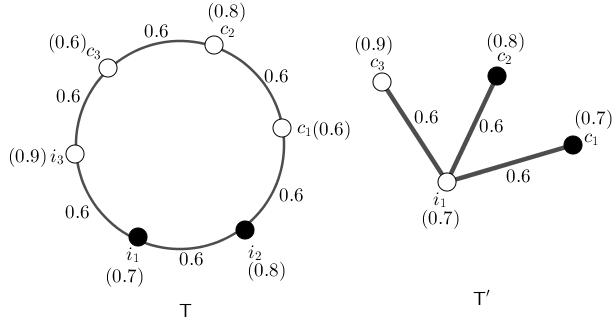
3 minute read
3.8 Optimal Sets For Neutrosophic Hypergraphs
2. Neutrosophic Chromatic Number
Step 1. (Definition) Time table is an approach to get some attributes to do the work fast and proper. The style of scheduling implies special attention to the tasks which are consecutive.
Advertisement
Step 2. (Issue) Scheduling of program has faced with difficulties to differ amid consecutive section. Beyond that, sometimes sections are not the same.
Step 3. (Model) As Figure (2.7), the situation is designed as a model. The model uses data to assign every section and to assign to relation amid section, three numbers belong unit interval to state indeterminacy, possibilities and determinacy. There’s one restriction in that, the numbers amid two sections are at least the number of the relation amid them.
Table (4.5), clarifies about the assigned numbers to these situation.
Figure 2.7: Black vertices are suspicions about choosing them.
Table 2.5: Scheduling concerns its Subjects and its Connections as a Neutrosophic Graph in a Model.
Sections of T s1 s2 s3 s4 s5 s6 s7 s8 s9, s10
Values 0.1 0.8 0.7 0.8 0.1 0.3 0.6 0.5 0.2 Connections of T s1s2 s2s3 s3s4 s4s5 s5s6 s6s7 s7s8 s8s9 s9s10
Values 0.1 0.6 0.4 0.1 0.1 0.2 0.4 0.2 0.1
Step 4. (Solution) As Figure (2.7) shows, neutrosophic model, proposes to use different types of chromatic number which is incomputable for types IV,V,VI,VII in the case which is titled T . In this case, i1 and c1 aren’t representative of these two colors and different types of chromatic number is incomputable for types IV,V,VI,VII. The set {i1, c1} doesn’t contain representatives of colors which pose different types of chromatic number and different types of chromatic number for types IV,V,VI,VII. Thus the decision amid choosing the subject c1 an c2 isn’t concluded to choose c1 for types IV,V,VI,VII. To get brief overview, neutrosophic model uses one number for every array so 0.9 means (0.9, 0.9, 0.9). In Figure (2.7), the neutrosophic model T introduces the common situation. The
98
fgr1c
tbl1c
2.32. Open Problems
representatives of colors are i2 and c1. Thus different types of chromatic numbers is two for types I and IV and different types of neutrosophic chromatic number is 1.4 for types I and IV. Thus suspicion about choosing i1 and i2 is determined to be i2. The sets of representative for colors are {i2, c1} for types I and IV. Thus the comparative studies based on different types of chromatic number and neutrosophic chromatic number are concluded.
2.32 Open Problems
The two notions of coloring of vertices concerning different types of chromatic number and different types of neutrosophic chromatic number are defined on neutrosophic graphs when connectedness and as its consequences, different types of edges have key role to have these notions. Thus Question 2.32.1. Is it possible to use other types edges via connectedness to define different types of chromatic number and different types of neutrosophic chromatic number? Question 2.32.2. Are existed some connections amid the coloring from connectedness inside this concept and external connections with other types of coloring from other notions? Question 2.32.3. Is it possible to construct some classes neutrosophic graphs which have “nice” behavior? Question 2.32.4. Which applications do make an independent study to apply different types of chromatic number and different types of neutrosophic chromatic number?
Problem 2.32.5. Which parameters are related to this parameter? Problem 2.32.6. Which approaches do work to construct applications to create independent study? Problem 2.32.7. Which approaches do work to construct definitions which use al l three arrays and the relations amid them instead of one array of three arrays to create independent study?
2.33 Conclusion and Closing Remarks
This study uses mixed combinations of different types of chromatic number and different types of neutrosophic chromatic number to study on neutrosophic graphs. The connections of vertices which are clarified by special edges and different edges from connectedness, differ them from each other and and put them in different categories to represent one representative for each color. Further studies could be about changes in the settings to compare this notion amid different settings of graph theory. One way is finding some relations amid array of vertices to make sensible definitions. In Table (2.4), some limitations and advantages of this study is pointed out.
99



